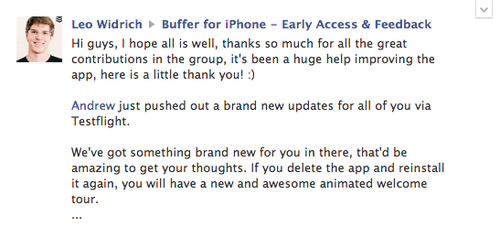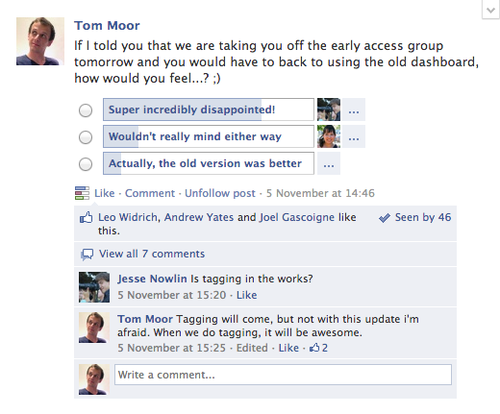An Amazing Way to Get Customer Feedback and Build a Community

So you’re building a new product or feature and want to gather feedback from your users… If you are building a startup this is probably a situation you have been in many times before and there are tons of ways you could go about doing this. An email list, forums or customer support software like Get Satisfaction / UserVoice are popular ways to gather feedback
At Buffer we found ourselves wondering if there was a better way, where the whole team could have a proper conversation with users and gather feedback incredibly fast as we rolled out new features and changes every few days.
We decided to do something a little different and use Facebook groups. We created a group for each of the three parts of our product that we are most actively working on (Web, iOS, Android) and invited anyone that wanted to join and help test the next versions of the apps in return for early access weeks or months before anyone else. Hundreds of people joined after just a few tweets on the company account - It’s hard to resist the lure of a beta test!
The Benefits
Easy and personal
At this point most people that are likely to want to test your product have a Facebook account and feel very comfortable with the interface and idea of groups. This means to get involved they only have to click one button with no extra sign in or learning curve.
Notifications
When you post an update to a group this usually shows up in members notifications and stream, it doesn’t clutter up their inbox but makes sure that members are always up to date with what’s going on. If the group isn’t secret (I would recommend a public group) then when people join their friends may also see this in the stream which spreads the word even further, maybe even introducing new people to your product.

Speed
Facebook is quick, very quick - we’ve seen comments come in just minutes after a new release has been pushed to testers. Members often see the notification on the web or their mobile phone and check out changes immediately!

Community
But the best aspect has to be the sense of community that is created, group members chat, help each other out and like posts that they agree with. We’ve run polls, asked questions and given advice - the whole team jumps in to help people out and comment on bug reports and feature requests.
It’s great having everyone’s face and real name, there is an amazing feeling that we are getting to know our users better and i’m sure they feel the same way about talking directly to the team and seeing that they are directly influencing the product. I’m confident that those in the groups will become some of our most loyal and outspoken users.

The Drawbacks
Of course, after using groups for several months we have found some drawbacks. There will always be a couple of people that don’t have or want a Facebook account, even for a social startup like ours!
Deploying features
There is also some work in making sure that everyone in the group gets the new features, whether this is enabling them in our admin area, sending out builds or manually adding people to TestFlight. Perhaps in the future this is something we could automate using the Facebook API but at the moment when bug reports come in it can be difficult to know which build someone is using or what version of the website they are seeing.
Over communicate
Ordering of posts in the group is automated, meaning that old posts often get pulled up above newer posts. Posts can be pinned so they stay at the top of the group but you definitely have to over-communicate and assume that previous posts may not have been read.
Conclusion
Overall in the last few months we have found Facebook groups to be an amazing way to connect with our most passionate users no matter where they are located. We’ve also collected some amazing feedback which has helped to shape the next version of Buffer with is launching very soon.
If you don’t currently do anything like this at your startup - give it a try! Start a group, invite your most enthusiastic users to join in and leave a link in the comments :-)